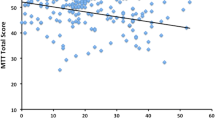Abstract
Six years befor the present study we performed a retrospective study of 114 subjects presenting with asymptomatic / oligosymptomatic hyperckemia (raised creatine kinase blood levels), a diagnosis being made in 21 of them. We now present the results of a long-term follow-up in 55 of the still undiagnosed 93 individuals. Most of them have remained asymptomatic and did not develop specific neuromuscular disorders. One subject became frankly symptomatic manifesting limb-girdle weakness. A diagnosis of dystrophinopathy carrier and one of possible type I SMA carrier were indirectly made in another two subjects. Almost all subjects still have hyperckemia, though the mean creatine kinase (CK) value is lower than before. CK levels have become normal in 12 subjects. Two died of neoplasia, and six developed non-neuromuscular disorders. We noted no follow-up differences in terms of CK modifications between subjects with pathological EMG and/or muscle biopsy findings and those with normal findings at first examination.



Similar content being viewed by others
References
Brewster LM, De Visser M (1988) Persistent hyperCKemia: fourteen patients studied in retrospect. Acta Neurol Scand 77: 60–63
Davis CS, Koch GG (1995) Cary - Categorical Data Analysis Using the SAS System - Strokes ME. SAS Institute Inc, NC
Dystrophinopathy in isolated cases of myopathy in females. E.P. Hoffman, K. Arahata, C. Minetti, E. Bonilla, L. P. Rowland and co-authors. Neurology, 1992: 967–975
Eng C, Skolnick AE, Come SE. Elevated creatine kinase and malignancy. Hosp Pract (Off Ed). Harvard Medical School, Boston. Dec 1990; 15: 25(12):123, 126, 129–30
Galassi G, Rowland LP, Hays AP, Hopkins LC, DiMauro S (1987) High serum levels of creatine kinase: asymptomatic prelude to distal myopathy. Muscle Nerve 10:46–350
Hagberg M, Michaelson G, Ortelius A (1982) Serum creatine kinase as an indicator of local muscular strain in experimental and occupational work. Int Arch Occup Environ Health 50:377–386
Hosmer DW, Lemeshow S (1989) Applied Logistic regression. John Wiley & Sons, NY
Katirji, MD, FACP, Mohamed M. Al-Jaberi. Creatine Kinase revisited. MD J Clin Neuromusc Dis 2001
Laval SH, Bushby KM. Limb-girdle muscular dystrophies–from genetics to molecular pathology. Neuropathol Appl Neurobiol. 2004:30(2):91–105
Meltzer HY (1971) Factors affecting serum creatine phosphokinase levels in the general population: The role of race, activity and age. Clin Chim Acta 33:165–172
Minetti C, Sotgia F, Bruno C, et al. (1998) Mutations in the caveolin-3 gene cause autosomal dominant limb-girdle muscular dystrophy. Nat Genet 18:365–368
Munsat TL, Baloh R, Pearson CM, Fowler W (1973) Serum enzyme alterations in neuromuscular disorders. JAMA 226(13):1536–1543
Nanji AA (1983) Serum creatine kinase isoenzymes: a review. Muscle Nerve 6:83–90
Prelle A, Comi GP, Rigoletto C, et al. (1997) An atypical case of partial merosin deficiency congenital muscular dystrophy. J Neurology 244:391–395
Prelle A, Rigoletto C, Moggio M, Sciacco M, Comi GP, Ciscato P, Fagiolari G, Rapuzzi S, Bignotti V, Scarlato G (1996) Asymptomatic familial hyperCKemia associated with desmin accumulation in skeletal muscle. J Neuro Sci 140:132–136
Prelle A, Tancredi L, Sciacco M, Chiveri L, Comi GP, Martinelli-Boneschi FM, Bagnardi V, Battistel A, Ciscato P, Bordoni A, Fortunato F, Bazzi P, Strazzer S, Bresolin N, Scarlato G, Moggio M (2002) Retrospective study of a large population of patients effeceted with asymptomatic or paucisymptomatic hyperCKemia. J Neurol 249:305–311
Reijneveld JC, Notermans NC, Linssen WHJP, Wokke JHJ (2000) Benign prognosis in idiopathic hyper-CK-emia. Muscle Nerve 23:575–579
Rowland LP, Willner J, DiMauro S, Miranda A (1980) Approaches to the membrane theory of Duchenne muscular dystrophy. In: Angelini C, Danieli GA, Fontanari D (eds) Muscular Dystrophy-Advances and New Trends. Excerpta Medica, Amsterdam pp 3–13
Sunohara N, Takagi A, Nonaka I, Sugita H, Satoyoshi E (1984) Idiopathic hyperCKemia. Neurology 34:544–547
Wong ET, Cobb C, Umehara MK, Wolff GA, Haywood LJ, Greenberg T, Shaw ST (1983) Heterogeneity of Serum Creatine Kinase Activity among Racial and Gender Groups of the population. Am J Clin Pathol 79:582–586
Acknowledgements
The financial support of Associazione Amici del Centro Dino Ferrari-University of Milan, the Telethon project GTF02008, the Eurobiobank project QLTR-2001–02769 and R.F. 2002 Criobanca Automatizzata di Materiale Biologico are gratefully acknowledged.
Author information
Authors and Affiliations
Corresponding author
Additional information
Received in revised form: 5 August 2005
Rights and permissions
About this article
Cite this article
D’Adda, E., Sciacco, M., Fruguglietti, M.E. et al. Follow-up of a large population of asymptomatic/oligosymptomatic hyperckemic subjects. J Neurol 253, 1399–1403 (2006). https://doi.org/10.1007/s00415-006-0223-y
Received:
Accepted:
Published:
Issue Date:
DOI: https://doi.org/10.1007/s00415-006-0223-y




